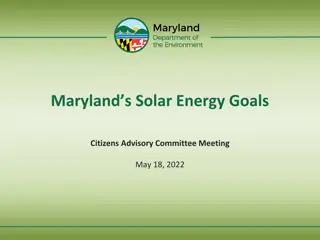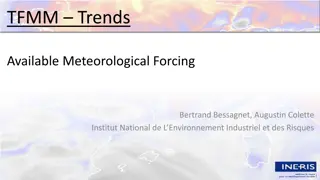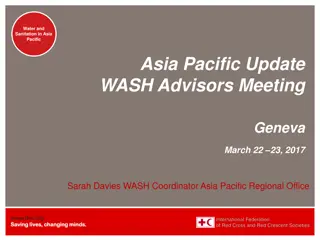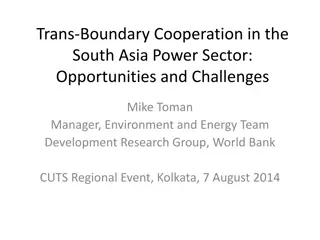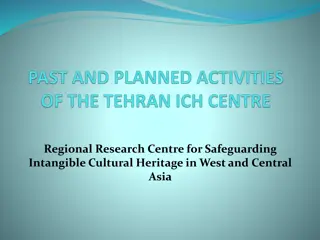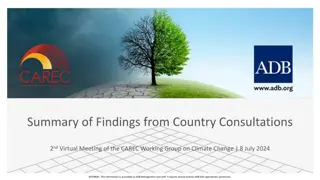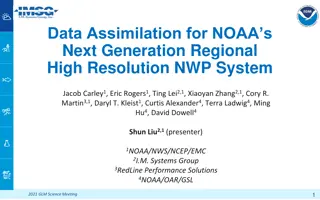Regional Climate Modeling in CORDEX South Asia for Climate Change Research
This information details the regional climate modeling efforts within the CORDEX South Asia framework, focusing on high-resolution dynamical downscaling of CMIP5 climate projections. It highlights the activities, opportunities, and challenges for assessing regional climate change, along with future projections and research publications analyzing RCM outputs. The data access portals for CORDEX South Asia simulations and the role of Climate Data Store in preserving CORDEX data are also discussed.
Download Presentation

Please find below an Image/Link to download the presentation.
The content on the website is provided AS IS for your information and personal use only. It may not be sold, licensed, or shared on other websites without obtaining consent from the author. Download presentation by click this link. If you encounter any issues during the download, it is possible that the publisher has removed the file from their server.
E N D
Presentation Transcript
Regional Climate Modeling In The Framework Of CORDEX South Asia Sanjay Jayanarayanan Centre for Climate Change Research (CCCR) Indian Institute of Tropical Meteorology (IITM), Pune, India An Autonomous Institute of the Ministry of Earth Sciences, Govt.of India
Regional Climate Information for Application Studies CORDEX South Asia https://cordex.org/domains/region-6-south-asia-2/ is leading CORDEX (Coordinated Regional Climate Downscaling Experiment) over South Asia Region High Resolution (50 km) Dynamical Downscaling of CMIP5 Climate Projections based on RCP Scenarios during 1950-2100 using multiple RCMs More information for CORDEX South Asia data access from CCCR-IITM Climate Data Portal and ESGF datanode are provided at: http://cccr.tropmet.res.in/home/cordexsa_datasets.jsp
CORDEX South Asia (WAS) Activities Opportunities and Challenges for better assessment of regional climate change More than 40 research publications (2014 onwards) analysed the RCM outputs from the CORDEX South Asia ensemble (see http://cccr.tropmet.res.in/home/cordexsa_pub.jsp ) Future global meteorological drought hot spots: A study based on CORDEX Data (Spinoni et al., 2020) Contrasting regional and global climate simulations over South Asia (Rana et al., 2020) Added value of CORDEX-SA experiments in simulating monsoon precipitation over India (Choudhary etal.2018) ISMR (Fig. 16, Singh et al., 2017) Understanding the cascade of GCM and downscaling (dynamical versus statistical) uncertainties in capturing the spatio-temporal variability of hydro- climatic projections over India (Sharma et al., 2017) AV JJAS mean precip (Fig. 2, Choudhary et al., 2018) Do dynamic regional models add value to the global model projections of Indian monsoon? (Singh etal, 2017) Ensemble mean JJAS 1951-2007 (Fig. 4, Mishra 2015) Climatic uncertainty in RCMs is far larger than observations over the Himalayan water towers (Mishra 2015) Reliability of regional and global climate models to simulate precipitation extremes over India (Mishra et al., 2014) Grid cells (in red) where models show bias ( 10%) for 1 day precip maxima at 25 year return period and (d) models and the area (%) (Fig. 9, Mishra et al. 2014)
CORDEX South Asia future projections of regional climate change over India (In Krishnan et al., 2020) Source: Krishnan et al., (2020) SpringerNature; https://doi.org/10.1007/978-981-15- 4327-2
CORDEX simulations are stored in a distributed archive (the Earth System Grid Federation, ESGF) after standardization & curation: https://cordex.org/data-access/regional-climate-change-simulations-for-cordex-domains/ Climate Data Store (CDS) CORDEX data subset The CDS subset of CORDEX data is an effort done by Copernicus to consolidate a World-wide CORDEX dataset, and has also contributed to the IPCC-AR6 WGI activities https://cds.climate.copernicus.eu/cdsapp#!/dat aset/projections-cordex-domains-single- levels?tab=overview https://cordex.org/wp- content/uploads/2020/12/CORDEX_simulations_Dec_2020.xlsx
Spatial distribution of annual maximum 1-day precipitation (Rx1day, mm) over South Asia and averaged for the historical reference period 1986-2005 from the multi-model ensemble (MME) mean of global (CMIP6 and CMIP5) and downscaled regional (CORDEX South Asia) historical climate simulations. adjoining regions Rx1day is an index for CID category Heavy Precipitation & Pluvial Floods The spatial maps are drawn online using the IPCC Interactive Atlas (Guti rrez et al., 2021; https://interactive-atlas.ipcc.ch/ )
Climate Models Simulated Regional to Local Precipitation Extremes HadEX3 APHRO IMD Climatological spatial distribution of Rx1day magnitudes over the Kerala State and adjoining regions shows that the downscaled high resolution CORDEX MME mean simulated the intense precipitation extremes relatively closer to observed (APHRODITE) estimates than the coarse resolution CMIP5 and CMIP6 MME means. CORDEX CMIP6 CMIP5 Rx1day Mean Rx1day Bias The spatial maps are drawn using the data extracted from IPCC Interactive Atlas (Guti rrez et al., 2021; https://interactive-atlas.ipcc.ch/ )
Climate Change Driven Changes in Precipitation Extremes Near-Term (2021-2040) Scenario Low Medium High Global Warming Levels 1.5 C 2.0 C 4.0 C Analyses global regional climate projections implies that scenarios with low GHG emissions (RCP2.6 and SSP1-2.6) would lead to substantially smaller changes in annual Rx1day beyond 2040 than under very high GHG emissions scenarios (RCP8.5 and SSP5- 8.5) over the Kerala State and adjoining regions of and MME downscaled mean CMIP6 index CMIP5 CORDEX The spatial maps are drawn using the data extracted from IPCC Interactive Atlas (Guti rrez et al., 2021; https://interactive-atlas.ipcc.ch/ )
Summary & Knowledge Gaps The evaluation of global and downscaled regional climate model performance will provide confidence to the analyses of projected changes from these model outputs. Climate information as provided by the IPCC may be too coarse, too broad or too disciplinary to directly inform decision-making at the national, local or sectoral level where adaptation planning measures are taken IPCC AR6 had assessed that there is high confidence that Climate Services has set new scientific challenges to physical climate research Understanding and modelling of weather and climate extremes is of great relevance for Climate Services, and is continuing to set challenges for research, such as modelling changes relevant threshold exceedance and return periods for a variety of extremes in impact-
Convection-Permitting Third Pole (CPTP) CORDEX-FPS: High resolution climate modeling with a focus on mesoscale convective systems and associated precipitation over the Third Pole region http://rcg.gvc.gu.se/cordex_fps_cptp/ CCCR-IITM is a modeling partner in this five year (2020-2024) International CORDEX Flagship Pilot Study (FPS) project This FPS aims to better understand the regional characteristics of water cycle and its variabilities and changes over the TP and adjoining regions using a set of coordinated high resolution regional climate downscaling experiments carried out by international participants with a focus on convection-permitting simulations (2-5 km) using different models or model setups. The first results from multi-model, multi-physics ensemble simulations of three case studies show high performance across a range of meteorological situations and are close to available observational estimates in simulating precipitation and near-surface temperature. https://doi.org/10.1007/s00382-022-06543-3
https://www.wcrp-climate.org/wgcm-cmip/wgcm-cmip6 https://cordex.org/data-access/how-to-access-the-data/ http://cccr.tropmet.res.in/home/data_portals.jsp Thanks for your attention Email: sanjay@tropmet.res.in Thank You ICRC-CORDEX 2023 Organisers Director IITM CCCR-IITM Team Members











